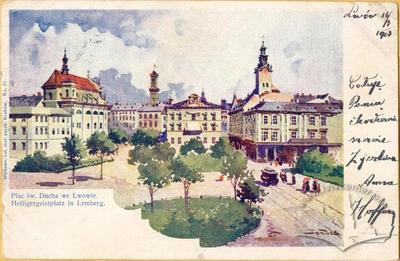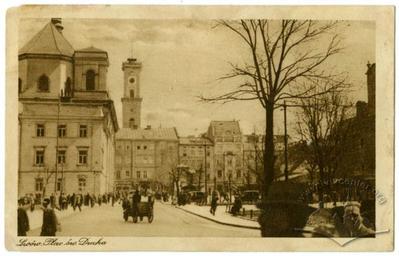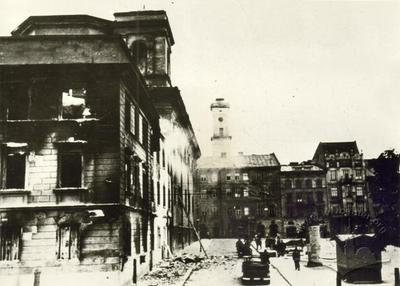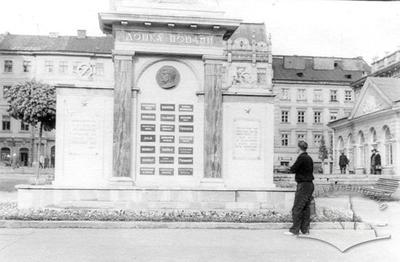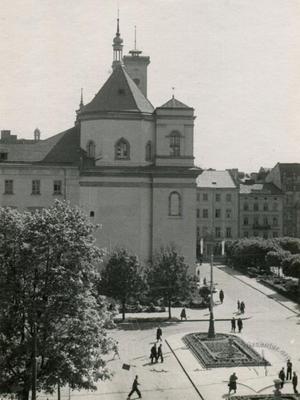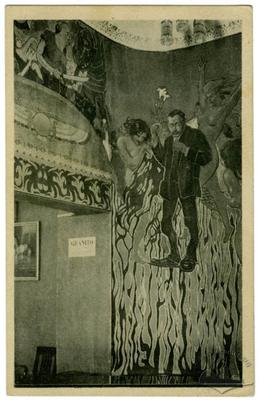Vul. Teatralna, 10 – residential building ID: 161
The building situated on Teatralna street 10 was erected between 1768-1773 in the late Baroque style with some Neo-Classicist elements; it is likely that it was designed by Piotr Połejowski. According to the resolution of the Council of Ministers of the Ukrainian SSR number 970 dated 24 August 1963, the house number 10 on Teatralna street was entered in the register of local architectural monuments under protection number 367. Today it is a residential house; a hostel named "Na Teatralniy" is also located there; some ground floor premises are occupied by the watch salon "Geneva", a clothing shop and a bistro.
Story
16th c. – there are two townhouses, the Kozlovska one and the Shalinska one, in the place where the present building stands.1557 – the Shalinska townhouse is owned by Felix Turkiewicz (Schall).
1615 – the Shalinska townhouse is owned by Paweł Kampian.
1642 – the Shalinska townhouse is owned by Paweł Wojakowski.
1715 – the ruined Kozlovska townhouse is bought by Mikołaj Gordon.
Early 18th c. – the Shalinska townhouse is owned by the families of Ziętkiewicz and Czeczewicz.
1767 – the Kozlovska townhouse is bought by Roch Wieniawski.
1768 – the Shalinska townhouse is bought by Roch Wieniawski.
1768-1773 – a new townhouse is built by constructor Józef Dublowski.
1852 – the figure of Mars is made by sculptor Paul Eutele.
1852 – a ground floor window is rearranged as a door.
Mid-19th c. – the fourth floor is added.
1907 – a new wing is built and an old courtyard wing is reconstructed under a project designed by architect Włodzimierz Podhorodecki.
1907 – the staircase is reconstructed under a project designed by architect Włodzimierz Podhorodecki.
The house (old conscription number 72, new conscription number 42), like many others in the central part of the city, was built in the place of two old townhouses, the Kozlovska one and the Shalinska or Salinska one. In the 17th c. the former belonged to the Magistrate clerk Paweł Kozłowski. It had three stories then, the façade was 20.3 cubits long. Around 1715 it was purchased by Mikołaj Gordon, a member of the city council of Lviv. The house was in such a bad condition at that time that in the same year it was assessed as not subject to repair. In 1767 the ruin was bought by Roch Wieniawski who was a general of the crown army, the Przemysl podczaszy (deputy cup-bearer) and the landlord of the villages of Pustomyty, Volytsya and Myloshovychi.
The second townhouse, the Shalinska one, belonged to Felix Turkiewicz, nicknamed Schall, in 1557. In 1615 it became owned by Martin Kampian and his wife Elżbieta Kampian, née Abramowicz. Martin Kampian, as it is known, was a doctor of medicine and burgomaster; it was during his time in office that the Lviv City Hall tower was constructed (1619). In 1642 Martin’s widow Elżbieta sold her townhouse to Paweł Wojankowski for 4 thousand guldens. In the first half of the 18th c. the Ziętkiewiczs and later the Czeczewiczs lived there. It was from the Czeczewiczs that in 1768 the townhouse was transferred to the ownership of Roch Wieniawski. The house was also known as the “Jesuit bursa” as it was rented by the Jesuit college for their students. At the time of its purchase by Wieniawski it was also in a rather bad condition. On the night of 20 July 1768 its roof and ceiling collapsed.Thus, having bought the ruins of the Kozlovska and Shalinska townhouses, Roch Wieniawski rebuilt them as a single one. The reconstruction began in 1768 from the Kozlovska house. The Shalinska townhouse stood in ruins till 1769 when stonemasons started to dismantle it. Before the house was bought by Wieniawski its ruins had been used by magistrate counsellor Kazimierz Czeczewicz who appropriated some building materials like stone, bricks etc. The construction lasted several years. When in 1771 the townhouse of Michał Rzewuski on Rynok square 3 was being built, a stone slab for its balcony was bought from Wieniawski’s site. This fact shows that general Wieniawski’s house was still being built at that time. The construction was probably completed in 1773, as on 18 March 1774 Antoni Miskiewicz and Paweł Szenderowicz, guild stonemasons, assessed the newly constructed building. A new boundary wall and the use of the old one are mentioned in their signed report. The construction was managed by Józef Dublowski, a constructor. It was also he who built the neighbouring townhouse (Teatralna street 8) for Franciszek Dewicz, the starosta (royal official) of Radelychi. The architect of the townhouse was probably Piotr Polejowski; this is shown by some architectural details. Apart from that, general Wieniawski, as a wealthy and ambitious person, could not help engaging a famous architect granted with a royal privilege. Moreover, it was architect Piotr Połejowski who conducted the assessment of the boundary wall between townhouses 8 and 10 on Teatralna street on 25 August 1775.
General Roch Wieniawski did not enjoy his new home for a long time; he died childless shortly. According to his will, drawn up at Czarna on 24 November 1775, he bequeathed his estates of Pustomyty and Volytsya, as well as his townhouse in Lviv, to his brothers Józef, Michał, and Antoni Wieniawski. He also bequeathed a third of the townhouse to his wife Urszula Wieniawska, née Szembek. In 1763, being in the Pidhirtsi Basilian monastery at Plisnesk, he bought there icons of St. Roch and St. Ursula, his and his wife’s patrons, for 72 guldens. Michał Wieniawski’s widow, Antonina, married Yakiv Kulchytsky, a Ukrainian who was a counsellor of the Galician Appeal Tribunal and a member of the Stauropegion Institute. After Józef Wieniawski granted his part of the house in 1786 to Yakiv Kulchytsky, the latter became the owner of the whole townhouse of the Wieniawskis. His adopted daughter married count Felix Raciborski. It is likely that this is the same Yakiv Kulchytsky, who, along with his relatives Kostiantyn and Mykhaylo, left a graffiti with the names on the frieze of the Assumption Church in Lviv (the north side above the babynets), dated back to the second half of the 18th c. Ironically, these names entered the history of Ukrainian art as the names of those who made the reliefs on the Assumption Church’s frieze in the early 17th c.
In 1826 the house was transferred from Yakiv Kulchytsky (then already deceased) to Johann Tränkel. The Brojer family, related to the Tränkels, lived there too.
In the 19th c., when the house belonged to the Tränkels and Brojers, some interior and exterior transformations were made in it. In 1852 Johann Tränkel rearranged a ground floor window as a door. It was probably the Tränkels who changed the façade, giving it a modern look, that is, adding the fourth floor. Some changes also took place in it in the early 20th c. In 1907 a new wing was built and an old courtyard wing was reconstructed under a project designed by architect Włodzimierz Podhorodecki. Under his project, the staircase was reconstructed in 1908 and some changes were made in the interior. In the same year Podhorodecki designed a project allowing to reconstruct the gate as a shop. All ground floor premises are covered with cross vaults. Art exhibitions were arranged in the townhouse’s second floor premises around the 1880s.
Architecture
The townhouse built by Roch Wieniawski had a slightly different look than it has now. In a 1843 drawing by Bartnicki, stored in the Lviv History Museum, it has three stories and a marked out central part completed with a pediment having a trophy and three semicircular windows of the mansard room. The house has a mansard roof with lucarnes, embellished with a decorative metal grating above the lucarnes, that is typical to the Baroque architecture. The façade is decorated with smooth pilasters. The ground floor semicircular windows had shutters.Now the townhouse looks somewhat different. It has four stories and seven axes, low roof and no pediment. The façade is decorated with rusticated pilasters, its central part has an insignificantly projected avant-corps. The ground floor windows are decorated with grotesque stone male masks; the second floor windows have stucco reliefs with trophies. The building’s main accent is a Classicist portico with two pairs of columns supporting an entablature with a Dorian frieze; above the frieze, there are figures of Venus, or Minerva, and Mars lying on pedestals and symbolizing war and peace. Between the pedestals with the sculptures, there is a balcony constructed on a stone slab with a forged metal railing whose patterns resemble those of the balcony of the townhouse on the Rynor square 3, made by blacksmiths Piotr Sienkowacki and Jakób Zjajka. The female figure was made at the same time as the house itself, while the figure of Mars, according to the inscription on the muzzle of the gun, which Mars leans on, was made by sculptor Paul Eutele in 1850. The military attributes, Mars and the trophy, show that the house belonged to a person involved in military service, someone like general Wieniawski.
The townhouse’s portico, constructed in the classical order system, strongly resembles a quite similar one of the Metropolitan palace’s portico on the Svyatoyurska Hill. They were made virtually at the same time and, judging by their style, both belong to the late Baroque with some pronounced Neo-Classicist features.
People
Antoni Wieniawski – a brother of Roch Wieniawski.Antoni Miskiewicz – a Lviv guild stonemason.
Antonina Kulchytska – Michał Wieniawski’s widow who married Yakiv Kulchytsky.
Bartnicki – a 19th century artist.
Brojers – a family who lived in the townhouse in the 19th c.
Włodzimierz Podhorodecki – a Lviv architect.
Józef Dublowski (d. 1798) – a Lviv constructor.
Elżbieta Kampian, née Abramowicz – the wife of Martin Kampian.
Ziętkiewiczs – a family who owned the Shalinska townhouse in the first half of the 18th c.
Johann Tränkel – the owner of the house in the 19th .
Józef Wieniawski – a brother of Roch Wieniawski.
Kazimierz Czeczewicz – a counsellor of the Lviv city council in 1769.
Kostiantyn Kulchytsky – a relative of Yakiv Kulchytsky.
Martin Kampian (1574-1629) – a doctor of medicine, the city’s burgomaster.
Mikołaj Gordon – a Lviv Magistrate member in 1715.
Michał Wieniawski – a brother of Roch Wieniawski.
Michał Józef Rzewuski (1699-1769) – the voivode of Podolia and Podlachia, the great notary of the crown.
Mykhaylo Kulchytsky – a relative of Yakiv Kulchytsky.
Paweł Wojankowski – the owner of the Shalinska townhouse in the 17th c.
Paweł Kozłowski – a Magistrate clerk.
Paul Eutele (1804-1889) – a Lviv sculptor of German origin.
Paweł Szenderowicz – a Lviv guild stonemason.
Piotr Polejowski (1734-1776) – a Lviv architect.
Piotr Sienkowacki – a Lviv blacksmith.
Roch Wieniawski – the Przemysl podczaszy (deputy cup-bearer) and a general of the crown army.
Tadeusz Rutowski (1852-1918) – the president of the city of Lviv, an official and a publicist who lived in the townhouse.
Tränkels – a family who lived in the townhouse in the 19th c.
Urszula Wieniawska, née Szembek – Roch Wieniawski’s wife.
Felix (Schall) Turkiewicz – the owner of the Shalinska townhouse in 1557.
Felix Raciborski – a count, Yakiv Kulchytsky’s stepdaughter’s husband.
Franciszek Dewicz – the starosta (royal official) of Radelychi.
Czeczewiczs – a family who owned the Shalinska townhouse in the first half of the 18th c.
Jakób Zjajka – a Lviv blacksmith.
Yakiv Kulchytsky – a counsellor of the Galician Appeal Tribunal and a member of the Stauropegion Institute who owned the townhouse at the turn of the 19th c.
Organizations
Sources
- State Archive of Lviv Oblast (DALO) 2/2/5238.
- DALO 2/3/1321.
- Central State Historical Archives of Ukraine in Lviv (CDIAL) 52/2/127.
- CDIAL 52/2/367.
- Володимир Вуйцик, Державний історико-архітектурний заповідник у Львові. (Львів, 1991).
- Володимир Вуйцик, "Вулиця Театральна 10", Leopolitana ІІ, (Львів, 2013), 81-88.










